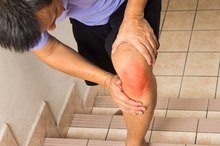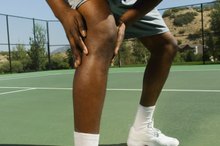Hyperextension of the Calf
Hyperextension injuries are common amongst runners and other athletes. Calf muscle injuries often occur during a workout that involves running or jumping when the muscle is not pliable. Since the calf is a muscle and not a joint, it cannot hyperextend, although it is possible to stretch it beyond its capacity, resulting in a muscle strain.
If you are experiencing serious medical symptoms, seek emergency treatment immediately.
Hyperextension Vs. Strain
Hyperextension happens when a joint stretches beyond its normal capacity. This occurs when playing sports or exercising and when performing any movement that causes the joints to bend in an unnatural way. Common hyperextension injuries occur at the wrist, elbow, shoulder and knee. A knee hyperextension injury can cause damage to ligaments in the knee and, depending on how the injury occurred, you can also pull your calf muscle. A stretched calf muscle is called a calf strain. Although it has been pulled beyond its normal capacity, it is not considered a hyperextension injury.
- Hyperextension happens when a joint stretches beyond its normal capacity.
- A knee hyperextension injury can cause damage to ligaments in the knee and, depending on how the injury occurred, you can also pull your calf muscle.
Strain
Torn Tendons & Ligaments From Hyperextension
Learn More
Calf strains are categorized into three grades. A grade 1 calf injury causes your calf to feel tight and you may feel twinges of pain. A grade 1 injury lasts two to five days. A grade 2 calf strain causes sharp pain, pain when walking, swelling, bruising and tightness and can last for a week or longer. A grade 3 injury causes severe pain, an inability to voluntarily contract your calf muscle and calf rupture.
- Calf strains are categorized into three grades.
- A grade 2 calf strain causes sharp pain, pain when walking, swelling, bruising and tightness and can last for a week or longer.
Treatment
Treatment for calf strain involves rest, ice, compression and elevation, also known as RICE. For minor calf strains, RICE and pain relieving ointment can be used for treatment. For severe strains, use ice as soon as possible to stop any internal bleeding and keep your leg elevated. If you have severe pain, seek medical treatment immediately.
- Treatment for calf strain involves rest, ice, compression and elevation, also known as RICE.
- For minor calf strains, RICE and pain relieving ointment can be used for treatment.
Prevention
Pain in the Quadriceps
Learn More
Prevent calf strain by stretching your calves properly before working out. Making your calf muscle more pliable and flexible reduces the risk of a strain. Flexibility is achieved through stretching the area before working out or playing sports. However, be careful not to stretch your calf to the point of pain. Pain is a good indication that the muscle has been overstretched, which increases your risk of a calf strain.
- Prevent calf strain by stretching your calves properly before working out.
- Pain is a good indication that the muscle has been overstretched, which increases your risk of a calf strain.
Related Articles
References
- Free Medical Dictionary: Hyperextension
- British Kendo: Common Injuries 4: Elbow Hyperextension
- MayoClinic.com: Hyperextended Knee: Cause of Serious Injury?
- Sports Injury Clinic: Calf Strain
- Sports Science Ortheopaedic Clinic: Calf Strain
- Bryan Dixon J. Gastrocnemius vs. soleus strain: how to differentiate and deal with calf muscle injuries. Curr Rev Musculoskelet Med. 2009;2(2):74-7. doi:10.1007/s12178-009-9045-8
- Dixon JB. Gastrocnemius vs. soleus strain: how to differentiate and deal with calf muscle injuries. Current Reviews in Musculoskeletal Medicine. 2009;2(2):74-77.
Writer Bio
April Khan is a medical journalist who began writing in 2005. She has contributed to publications such as "BBC Focus." In 2012, Khan received her Doctor of Public Health from the University of Medicine and Dentistry of New Jersey. She also holds an Associate of Arts from the Art Institute of Dallas and a Master of Science in international health from University College London.








